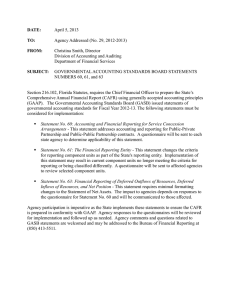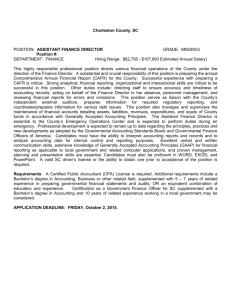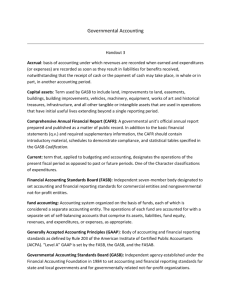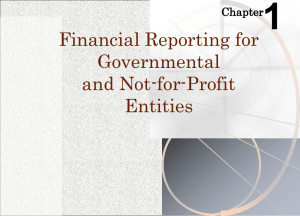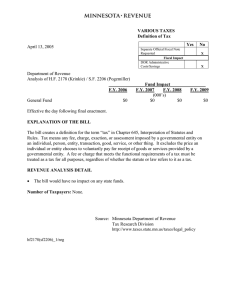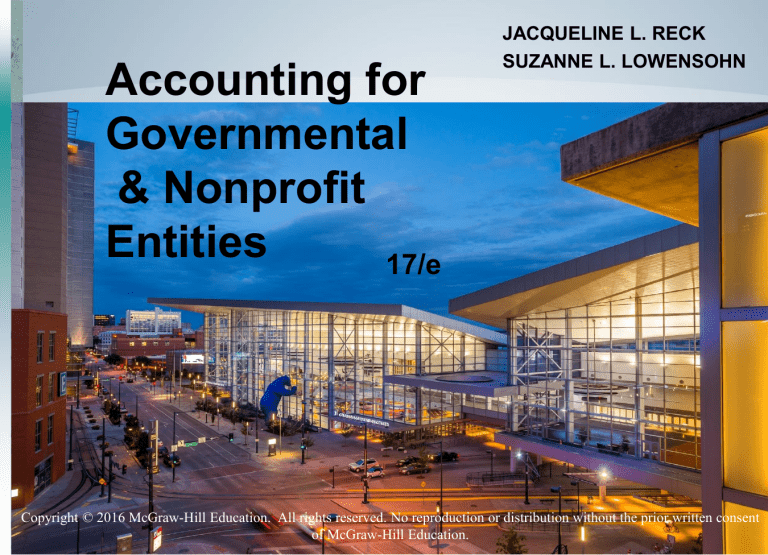
Accounting for Governmental & Nonprofit Entities 17/e JACQUELINE L. RECK SUZANNE L. LOWENSOHN Copyright © 2016 McGraw-Hill Education. All rights reserved. No reproduction or distribution without the prior written consent of McGraw-Hill Education. 9-1 Financial Reporting of State and Local Governments C H A P T E R 9 9-2 Learning Objectives 9-1 9-2 9-3 Describe the concepts related to the financial reporting requirements of the GASB reporting model. Explain the key concepts and terms used in describing the governmental reporting entity. Apply the GASB criteria used to determine whether a potential component unit should be included in the reporting entity and, when included, the manner of reporting component units. 9-3 Learning Objectives 9-4 9-5 9-6 Identify and describe the contents of a comprehensive annual financial report (CAFR). Prepare governmental fund financial statements and government-wide financial statements and understand how to reconcile the two. Identify and explain financial reporting issues and topics. 9-4 Conceptual Framework for Financial Reporting • Provide information that can be used to assess a government’s accountability • Assist users in making economic, social, and political decisions Primary Users • Those external to government; principally, citizens, legislative and oversight bodies, and creditors • • • • • • Understandable Reliable Relevant Timely Consistent Comparable Usefulness Objectives 9-5 Useful Information • Communicating the information in a manner that is helpful to the user is an important part of making information useful. • Areas identified in GASB Concepts Statement 3 are – recognition in the financial statements, – disclosures in the notes to the financial statements, – presentation as required supplementary information, or – presentation as supplementary information. 9-6 Recognition and Disclosure • An item of information that meets the definition of an element and is measurable with sufficient reliability should be recognized in the financial statements. • A note should be used if it can help support an item recognized in a financial statement or provide information that is essential to the user’s understanding of the item. 9-7 Required Supplementary Information (RSI) • Required supplementary information is used to provide information that is essential. • Without this information, the financial statements and related notes cannot be placed in the correct context. • Examples of RSI include the management discussion and analysis, budget to actual schedules and several pension disclosures. 9-8 Other Supplementary Information • Other supplementary information is used to provide information that is useful. • Other supplementary information is useful but not essential in understanding the financial statements and related notes. • Much of the other supplementary information is found in the statistical section of the comprehensive annual financial report (CAFR). 9-9 The Governmental Reporting Entity State or General purpose governments Other agencies Boards Primary Government Special purpose governments Special Districts Commissions 9-10 The Governmental Reporting Entity Primary Government Special Districts Other agencies Commissions Boards 9-11 Financial Reporting Entity • GASB takes the position that governmental financial reporting should report on all governments and organizations for which elected officials are accountable. • Collectively, these governments and organizations are referred to as the financial reporting entity. • A financial reporting entity is the primary government and organizations for which the primary government is financially accountable. 9-12 Financially Accountable A primary government is financially accountable for another organization if the primary government appoints a voting majority of the organization’s governing board AND it is (a) able to impose its will on the organization OR (b) there is a potential for the organization to provide specific financial benefits to, or impose specific financial burdens on, the primary government. 9-13 Component Units • Component units are included as a part of the reporting entity. • A component unit is defined as a legally separate organization for which the elected officials of the primary government are financially accountable. • Examples of component units include not-for-profit organizations, for-profit firms or a nonprimary government. 9-14 Presentation of Component Units Blended presentation is when the component unit’s financial data for its funds and activities are reported with the same fund types and activities of the primary government. Discrete presentation is when financial data of the component unit are reported in one or more columns, separate from the financial data of the primary government. 9-15 Is the Component Unit Part of the Primary Government? Is the governing body of the component unit substantially the same as that of the primary government? Is there is a financial benefit/burden relationship between the primary government and the component unit? Does the primary government have operational responsibility for the component unit? Does the component unit exist primarily to provide services to the primary government or otherwise exclusively, or nearly exclusively, benefit the primary government? Is the component unit’s debt expected to be paid entirely or almost entirely by the primary government? 9-16 Discrete Presentation Discrete presentation is used when The component unit does not meet the criteria for blending The assets received or held by the component unit are entirely or almost entirely for the direct benefit of the primary government, its component units, or its constituents The component unit is a legally separate, tax-exempt organization that meets both of the following criteria The primary government, or its component units, is entitled to, or has the ability to otherwise access, a majority of the assets received or held by the component unit and these assets are significant to the primary government. 9-17 Other Government Organizations Joint Venture Other stand-alone government Jointly owned organization 9-18 Governmental Financial Reporting • It is useful for financial reports to be prepared and distributed at intervals throughout a fiscal period as well as at period-end. • Reports prepared at times other than year-end are called interim reports. • Interim financial reports are useful for both government administrators and the legislative branch, especially those serving on the finance committee. 9-19 Suggested Interim Reports • Schedule of actual and budgeted revenue (for the General Fund and special revenue funds and other funds for which budgets have been legally adopted) • Schedule of actual and budgeted expenditures (for the General Fund and special revenue funds and other funds for which budgets have been legally adopted) • Comparative schedule of revenue and expense (for each enterprise and internal service fund) • Combined schedule of cash receipts, disbursements, and balances—all funds • Forecast of cash positions—all funds 9-20 Annual Financial Reports Management News media Debt rating agencies Legislature Users of Annual Financial Reports Citizens Creditors Higher governments 9-21 Comprehensive Annual Financial Report (CAFR) • CAFRs are prepared by most larger governments • A CAFR is the government’s official annual report prepared and published as a matter of public record • A CAFR includes the minimum requirements of general purpose external financial reporting: – management’s discussion and analysis (MD&A), – basic government-wide and fund financial statements and related notes, and – required supplementary information (RSI) 9-22 Comprehensive Annual Financial Report (CAFR) • In addition, a CAFR includes – – – – – – individual fund and combining financial statements, schedules, narrative explanations, a statistical section, other material management deems relevant, and if the CAFR contains audited financial statements, the auditor’s report should also be included 9-23 Sections of a CAFR Introductory Section Financial Section Statistical Section 9-24 Introductory Section • Since the introductory section is generally not covered by the auditor’s report, it may present information of a more subjective nature, including prospective information such as forecasts or expectations. • This section includes: – Table of contents – Letter of transmittal – Other material deemed appropriate by management 9-25 Financial Section The minimum content for the financial section of a CAFR includes – Auditor’s report – MD&A – Basic financial statements • Government-wide financial statements • Fund financial statements • Notes to the financial statements – Required supplementary information other than MD&A, including, but not limited to, the budgetary comparison schedule – Combining statements and individual fund statements and schedules 9-26 Statistical Sections • There are five categories defined by the GASB that should be included in the statistical section. The most recent 10 years of data should be presented for each. – Financial trends information – Revenue capacity information – Debt capacity information – Demographic and economic information – Operating information 9-27 Financial Trends Information Shows how a government’s financial position has changed over time Focus is on showing the trend in fund balances and net position categories Prepared at both the fund level and government-wide level 9-28 Revenue Capacity Information Shows the government’s ability to generate its own revenues Information on the revenue base Information on revenue rates Principal revenue payers Property tax levy and collection information 9-29 Debt Capacity Information Shows existing debt burden and ability to issue debt Ratios of outstanding debt to total personal income of residents Information about direct and overlapping debt Legal debt limitations and margins Information about pledged revenues 9-30 Demographic and Economic Information Shows socioeconomic environment in which the government operates Personal income Unemployment rates Employers 9-31 Operating Information Provides a context in which the government’s operations and resources can be better understood Number of government employees Indicators of demand or level of service Capital asset information 9-32 Preparing the Financial Statements • All necessary adjusting entries, including depreciation, should be prepared and posted. • A pre-closing trial balance is prepared to provide all information needed for the Governmental Activities column of the government-wide financial statements. • All temporary accounts should be closed. • Reclassification entries are prepared and posted for each of the three net position accounts. • The government-wide statements of net position and activities are prepared. 9-33 Fund Financial Statements • Fund financial statements are prepared for all governmental funds and proprietary funds. • Governmental fund financial statements include – Balance sheet – governmental funds – Statement of revenues, expenditures, and changes in fund balances—governmental funds • Fund balances must be classified according to constraints on their use: nonspendable, restricted, committed, assigned and unassigned. • Only the General Fund can have unassigned fund balances. 9-34 Required Reconciliations Fund financial statements reconcile to Governmental activities column 9-35 Other Financial Reporting Issues and Topics • GASB’s Recognition and Measurement Attributes project • Popular reporting • Other comprehensive basis of accounting (OCBOA) of special-purpose frameworks • International accounting standards 9-36 Looking Forward In this chapter, we explored financial reporting of state and local governments. Key concepts were explained, including that of component units. The contents of a CAFR were described and required reconciliations were identified. The next chapter begins Part 2 of the text which focuses on accountability for public funds. The chapter looks at the analysis of governmental financial performance. 9-37
